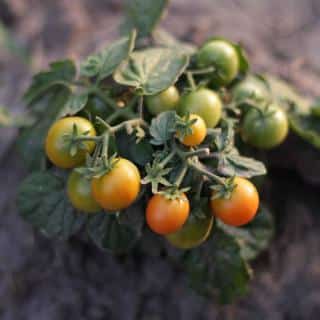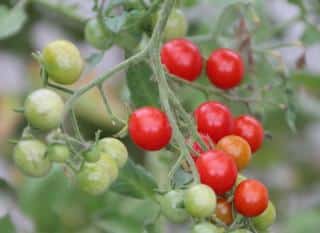

That burst of juicy sweetness in the mouth makes these the queens of appetizers! Cherry tomato is easy to grow in a pot, ideal for urban gardeners. A bit of pruning is necessary to make sure your harvest is abundant – and your fruits ripe!
Discover the best way to get this done.
Read also:
 Pruning occurs all summer long, as soon as you notice stems that must be removed. The goal, first and foremost, is to support fruit production.
Pruning occurs all summer long, as soon as you notice stems that must be removed. The goal, first and foremost, is to support fruit production.
First of all, remove any leaves and stems that bend down over to the point they’re touching the ground. It’s a fact: when they touch moist soil, they let diseases enter into the plant. Even though cherry tomato varieties are usually more resistant then their larger-sized cousins, it’s still better to anticipate and reduce the chance of this happening. Tomato plants, even cherry tomato, are often infected with mildew, a fungal disease that rots stems, leaves and fruits away. Another precaution is to avoid planting too densely: space plants out well.
Cherry tomato varieties are often very vigorous: they produce a lush abundance of stems and leaves. To concentrate sap and nutrients on fruit production, it’s best to reduce the amount of leafage overall. Select the 2 or 3 most vigorous stems on each foot, and cut the other ones out. This will do a lot towards guaranteeing a great harvest.
What’s a sucker? It’s a small stem that grows wherever secondary stems and leaves connect. You can locate it at the junction of secondary stems to the main stem. These young shoots absorb a lot of sap, and as a result hinders the plant’s growth. Removing them will thus divert extra sap and nutrients to the fruit-bearing stems.
It’s quite easy to break a sucker off: seize it between your thumb and forefinger, and bend it until it breaks off. Remember to wash your hands well beforehand, and to disinfect your tools: this reduces propagation of diseases. Pruning shears are perfect for topping the plant off, too.
Topping off means to cut the tip off the plant’s main stem. The taller the plant grows, the more side stems and leaves it produces. Since the root system doesn’t develop as fast as airborne parts, each fruit-bearing branch gets a little less sap and nutrients as new branches appear. This slows the ripening process down a lot.
It’s recommended to keep simply 4 to 6 groups of leaves, and to lop the top off above that. Tomato plants will produce fruit up through October, until the first frost spells hit. New fruits that form at the end of August don’t have much time to fully ripen. The point of topping off the plant is to concentrate all the available sap on existing fruits, to ensure that they easily mature before the season ends.
→ How to prune tomato plants? Tips and tricks
Thanks to your diligent pruning, you’ll certainly have a nice harvest coming up. It generally begins during the month of July and lasts until October. Harvesting takes place around 4-5 months after sowing, when the tomatoes take on a rich, red color.
Well, not necessarily red: some varieties turn other colors when they’re ripe, such as the ‘Green Grape’ (green-colored) and the ‘Gold Nugget’ (which turns golden yellow). What’s best is to harvest them a few at a time, whenever you need them, because these small sweet fruits won’t keep very well.
 If your cherry tomatoes are slow to ripen, you can actually pick the fruits when still green and help them mature by keeping them in a warm spot of the kitchen. Heat, not light, is what boosts ripening.
If your cherry tomatoes are slow to ripen, you can actually pick the fruits when still green and help them mature by keeping them in a warm spot of the kitchen. Heat, not light, is what boosts ripening.
Another technique is to place the tomatoes near other fruits that are known to release ethylene: apple, banana and pear for instance. This is a gas that triggers and speeds the ripening process up. Feel free to cover your fruit basket with a cloth to speed it up even more.